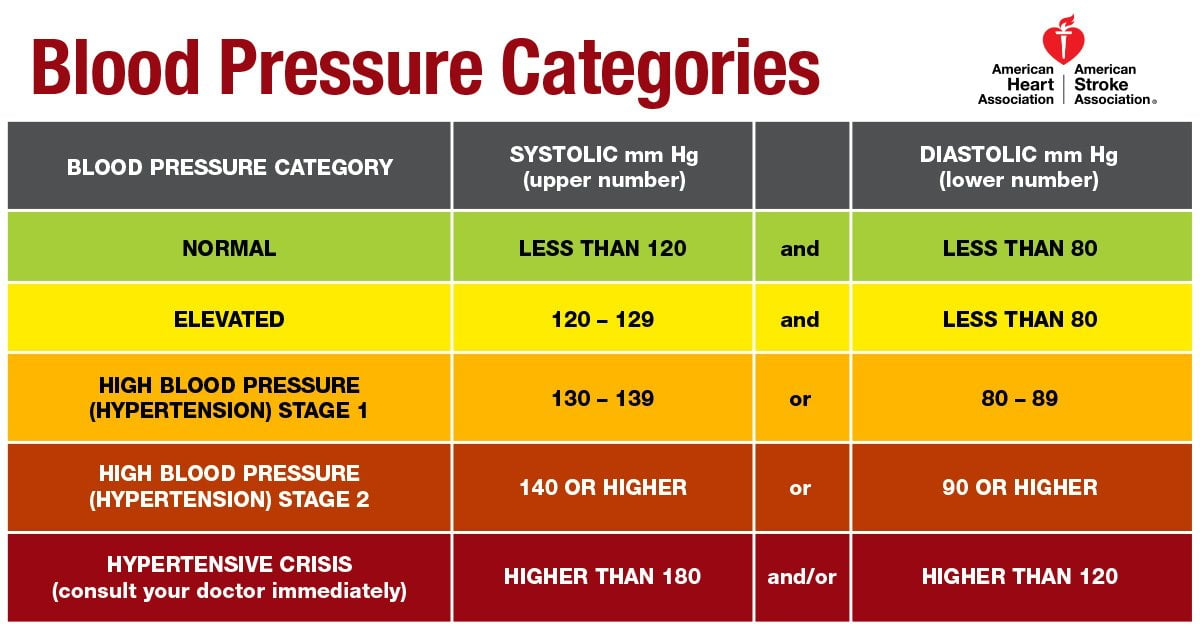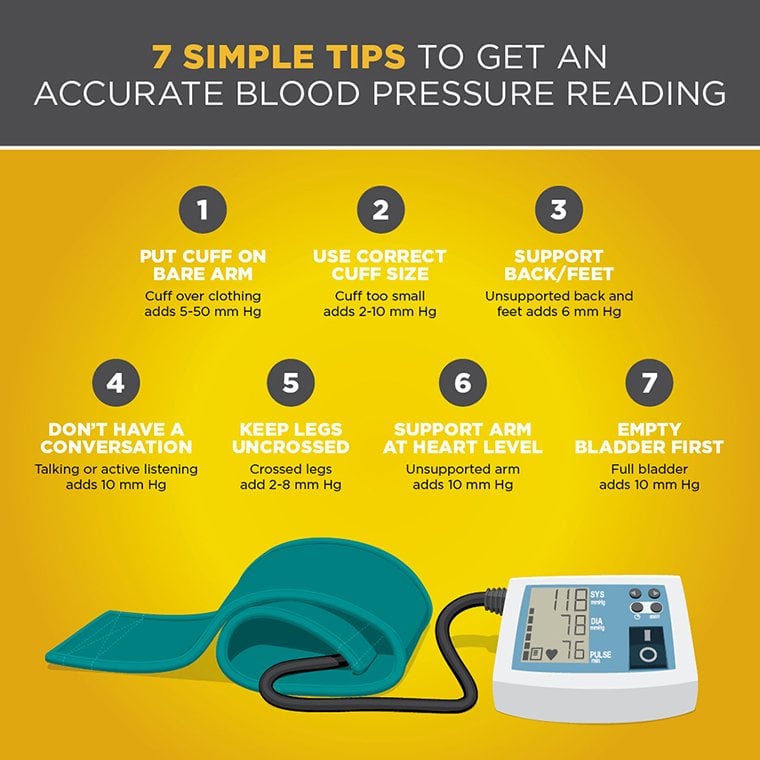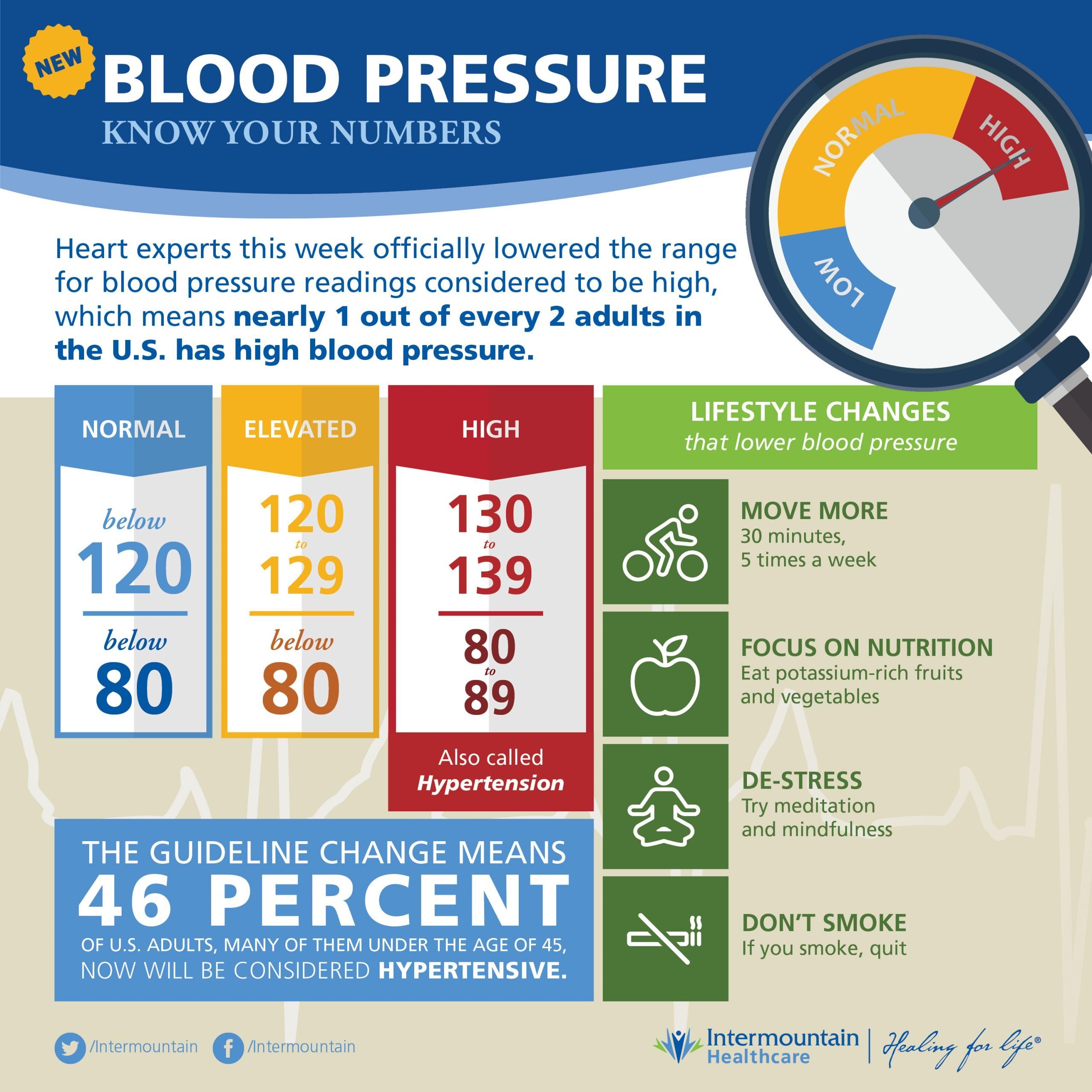What Is Considered High Blood Pressure For Older Adults
Recent updates to guidelines from the American Heart Association and the American College of Cardiology changed the definition of high blood pressure or hypertension for most people. High blood pressure is now generally defined as 130 or higher for the first number, or 80 or higher for the second number . However, there are important considerations for older adults in deciding whether to start treatment for high blood pressure, including other health conditions and overall fitness. If your blood pressure is above 130/80, your doctor will evaluate your health to determine what treatment is needed to balance risks and benefits in your particular situation.
Blood Pressure Is Diagnosed By A Doctor Using A Blood Pressure Machine The Process Includes:
- Being seated in a chair with your back supported
- Putting your feet flat on the floor and supporting your arm at heart level
- Remaining quiet for five minutes and refraining from talking
It is very important to use the proper size cuff when taking a blood pressure reading. Failure to do so will lead to inaccuracies. A cuff that is too small for the arm circumference will give an artificially high reading. A cuff that is too large will give too low a reading. Initially, blood pressure should be measured in each arm to make sure both readings are the same. The arm with the higher readings should then be targeted for all future blood pressure checks.
If your blood pressure readings are high, your doctor may ask that you return for additional measurements on different days because blood pressure can vary widely from day to day.
Your doctor will most likely diagnose you with high blood pressure if you have several readings of 140/90 or higher. If you have readings of 130/80 or higher and are diabetic or have chronic kidney disease, you are likely to be diagnosed with high blood pressure.
What can I do if I am diagnosed with high blood pressure?
Eat healthy food
Make sure your diet emphasizes fruits, vegetables, whole grains, and low-fat dairy foods. An easy tool for planning health meals is the Dietary Approaches to Stop Hypertension diet which can help you reduce your systolic blood pressure by 8-14 mm Hg.
Achieve and Maintain a Healthy Weight
Increase Physical Activity
Medications With Blood Pressure Of 230/130
Medications can have a big impact on your blood pressure. There are a variety of different types of blood pressure medications available. Following is a short list of each type of medication and what they do to reduce blood pressure.
- DiureticsHelps rid the body of sodium , which helps control blood pressure.
- Beta-blockersHelps reduce your heart rate, which helps lower blood pressure.
- ACE inhibitorsACE stands for Angiotensin-Converting Enzyme. Helps the body produce less angiotensin, which helps the blood vessels relax and lowers blood pressure.
- Angiotensin II receptor blockersHelps block the chemical that causes blood vessels to narrow, which helps blood vessels stay open and lowers blood pressure.
- Calcium channel blockersHelps lower blood pressure by preventing calcium from entering smooth muscle cells, which can cause stronger heart contraction and narrow blood vessels.
- Alpha blockersHelps relax certain muscles, which keeps blood vessels open and lowers blood pressure.
- Alpha-2 Receptor AgonistsHelps lower blood pressure by inhibiting sympathetic activity.
- Central agonistsUsing a different nerve path than Alpha and Beta blockers, Central agonists help relax blood vessels, which lowers blood pressure.
- VasodilatorsHelps dilate the blood vessels, which lowers blood pressure.
Talk with your doctor about changing or adjusting the dosage of medications to help bring your blood pressure readings down.
Recommended Reading: Does Spicy Food Cause High Blood Pressure
Which Number Is More Important
Typically, more attention is given to systolic blood pressure as a major risk factor for cardiovascular disease for people over 50. In most people, systolic blood pressure rises steadily with age due to the increasing stiffness of large arteries, long-term buildup of plaque and an increased incidence of cardiac and vascular disease.
However, either an elevated systolic or an elevated diastolic blood pressure reading may be used to make a diagnosis of high blood pressure. According to recent studies, the risk of death from ischemic heart disease and stroke doubles with every 20 mm Hg systolic or 10 mm Hg diastolic increase among people from age 40 to 89.
When To Check Blood Pressure

- If your blood pressure is normal , get it checked every year, or more often as your doctor suggests.
- If your blood pressure is elevated — a systolic blood pressure between 120 and 129 or diastolic blood pressure of less than 80 — your doctor will probably want to check it every 3-6 months. They will probably recommend lifestyle changes like more exercise and a better diet.
- If you have stage 1 hypertension — 130-139 over 89-90 — the doctor might suggest lifestyle changes and see you again in 3-6 months. Or they could tell you to make the changes and give you medication, then recheck your condition in a month. It depends on what other health conditions or risk factors you have.
- If you have stage 2 hypertension — 140/90 or higher — youâll likely get medication. You’ll also need to make lifestyle changes and see the doctor again in a month.
Read Also: Does Claritin Cause High Blood Pressure
Q: Does The Blood Pressure Of Patients Elevate At The Doctors Office
A: It does. Thats why 30 minutes before your appointment, we dont want you to have any caffeine. We dont want you exercising 30 minutes before your blood pressure is checked. And we dont want you smoking 30 minutes before your blood pressure is checked. We want you to be able to sit still for five minutes with your feet on the floor to allow you to come to a relaxed state. When the blood pressure is being checked, you want to make sure the cuff is above the elbow level. Make sure youre not talking during the check. The guidelines also emphasize rechecking your blood pressure in 30 minutes if it is elevated and then averaging those numbers.
Taking Your Pulse Versus Checking Your Blood Pressure
While both are indications of health, blood pressure and heart rate are two separate measurements. Learn more about the difference between blood pressure and heart rate.
Systolic is less than 120 and my diastolic is less than 80
Great job! Your blood pressure is normal. To keep your readings in this range, stick with heart-healthy habits like following a balanced diet and getting regular exercise.
Systolic is 120 129 and my diastolic is less than 80
The good news is that you dont have high blood pressure. However, your numbers fall within the Elevated category, making you more likely to develop high blood pressure unless you take action to control it. Ready to make some small changes that have big impacts? Healthy lifestyle choices are a great place to start.
Systolic is 130 139 or my diastolic is 80 89
You are in the first stage of hypertension, but there are actions you can take to get your blood pressure under control. Your doctor will speak to you about small changes that can make a big difference and other BP Raisers. In addition, monitoring blood pressure outside of the doctors office is important for BP control.
Systolic is 140 or higher or my diastolic is 90 or higher
Systolic is higher than 180 and/or my diastolic is higher than 120
Written by American Heart Association editorial staff and reviewed by science and medicine advisers. See our editorial policies and staff.
You May Like: Does Aspirin Raise Blood Pressure
New Blood Pressure Numbers: 130 Is Now High Doctors Say
13 November 2017
ANAHEIM, Calif. The bar for what’s considered “high blood pressure” just got lowered, meaning millions more Americans will now be classified as having the condition, according to new guidelines from several leading groups of heart doctors.
The guidelines, from the American Heart Association and the American College of Cardiology , now define high blood pressure as 130 mm Hg or higher for the systolic blood pressure measurement, or 80 mm Hg or higher for the diastolic blood pressure measurement. Previously, high blood pressure was defined as 140 mm Hg or higher for the systolic measurement and 90 or higher for the diastolic measurement.
The findings mean that an additional 14 percent of U.S. adults, or about 30 million people, will now be diagnosed as having high blood pressure, compared with the number diagnosed before the new guidelines. This will bring the total percentage of U.S. adults with high blood pressure to 46 percent, up from 32 percent previously.
However, the guidelines stress that, for most of the newly classified patients, the recommended treatment will be lifestyle modifications, such as weight loss and changes in diet and exercise levels, as opposed to medications. Only a small increase in the percentage of U.S. adults receiving blood pressure medications about 2 percent is expected, the authors said.
How Do I Know If I Have High Blood Pressure
Theres only one way to know if you have high blood pressure: Have a doctor or other health professional measure it. Measuring your blood pressure is quick and painless.
Talk with your health care team about regularly measuring your blood pressure at home, also called self-measured blood pressure monitoring.
High blood pressure is called the silent killer because it usually has no warning signs or symptoms, and many people do not know they have it.
Don’t Miss: Does Claritin D Raise Blood Pressure
Heart Attack And Heart Disease
High blood pressure can damage your arteries by making them less elastic, which decreases the flow of blood and oxygen to your heart and leads to heart disease. In addition, decreased blood flow to the heart can cause:
- Chest pain, also called angina.
- Heart attack, which happens when the blood supply to your heart is blocked and heart muscle begins to die without enough oxygen. The longer the blood flow is blocked, the greater the damage to the heart.
- Heart failure, a condition that means your heart cant pump enough blood and oxygen to your other organs.
Symptoms Of High Blood Pressure
High blood pressure symptoms typically include:
- Headache usually, this will last for several days.
- Nausea a sensation of unease and discomfort in the stomach with an urge to vomit.
- Vomiting less common than just nausea.
- Dizziness Lightheadedness, unsteadiness, and vertigo.
- Blurred or double vision .
- Epistaxis nosebleeds.
- Palpitations disagreeable sensations of irregular and/or forceful beating of the heart.
- Dyspnea breathlessness, shortness of breath.
Anybody who experiences these symptoms should see their doctor immediately.
Read Also: What Size Blood Pressure Cuff Do I Need
What Causes High Blood Pressure
High blood pressure usually develops over time. It can happen because of unhealthy lifestyle choices, such as not getting enough regular physical activity. Certain health conditions, such as diabetes and having obesity, can also increase the risk for developing high blood pressure. High blood pressure can also happen during pregnancy.
You can manage your blood pressure to lower your risk for serious health problems that may affect your heart, brain, kidneys, and eyes.
Million Americans Have High Blood Pressure Under New Guidelines

Everyone, even people with normal blood pressure, should watch their diet and exercise to keep blood pressure from going up, the new guidelines stress. And smoking is a major blood pressure risk.
Blood pressure of 120/80 or above is considered elevated 130/80 to 139/89 is now considered Stage 1 hypertension and anything 140/90 or above will be considered stage 2 hypertension. If blood pressure reaches 180/120 or higher and either number in the blood pressure reading counts people will be classified as in hypertensive crisis with need for immediate treatment or hospitalization.
Previously, people were not considered to have high blood pressure until the top reading hit 140. Normal hasnt changed. We are still saying that it is great and it is normal to have a systolic blood pressure reading below 120 and a diastolic reading under 80, Whelton said.
Related: High Blood Pressure Diagnoses Increase Among Teens
Rather than one in three U.S. adults having high blood pressure with the previous definition, the new guidelines will result in nearly half of the U.S. adult population having high blood pressure, or hypertension, the groups said in a joint statement.
Instead of recommending drug treatment right away, the organizations recommend that people with stage 1 hypertension try lifestyle changes first: exercising more, eating less salt, and eating more fruit, vegetables and whole grains.
Related: Study Confirms Lower Blood Pressure is Better
Read Also: What Is The Va Disability Rating For Hypertensive Heart Disease
What Blood Pressure Is Considered Normal
The normal pressure at which the top digit is less than 140, the lower value does not exceed 89.
Consider the case when the top value is 130, and the lower is 80. It is a high normal blood pressure.
When the age is approaching 40-50 years, such indicators are observed in most people.
Health is not affected. This can be with the young people, something normal.
Another thing, when people have lived all my life with blood pressure 110 over 70 and below. At higher rates symptoms as in hypertension.
There are hypertensive patients with the experience, accustomed to the fact that the monitor shows 150 over 90 or above, they felt themselves satisfactorily. Lower numbers are transferred is hard, there is a General weakness and dizziness.
What Is Normal And Recommended Blood Pressure
The normal blood pressure for young adults over 18 years is less than 130 mmHg systolic and 85 mmHg diastolic. A pressure between 130/85 and 140/90 is regarded as being at the higher level of normal. The normal blood pressure for older people over 65 years is less than 140 mmHg systolic and 90 mmHg diastolic. It is important for people with diabetes and kidney disease to keep their blood pressure below 130/85.
You May Like: Omron Bp785 Calibration
Why Your Blood Pressure Should Be Less Than 130/80
Your blood pressure is a good indicator of your overall health. Ideally, you want it to be less than 130/80 to prevent things like hypertension. However, what does this number mean, and why should your blood pressure be less than that?
What Is High Blood Pressure What Is Normal Blood Pressure
- High blood pressure is defined as high pressure in the arteries, which are the vessels that carry blood from the heart to the rest of the body.
- Blood pressure readings are given as two numbers:
- The systolic blood pressure equals the pressure in the arteries as the heart contracts.
- The diastolic pressure is the pressure in the arteries as the heart relaxes.
You May Like: What Size Blood Pressure Cuff Do I Need
Your Blood Pressure Numbers And What They Mean
Your blood pressure is recorded as two numbers:
- Systolic blood pressure indicates how much pressure your blood is exerting against your artery walls when the heart beats.
- Diastolic blood pressure indicates how much pressure your blood is exerting against your artery walls while the heart is resting between beats.
When To See A Doctor
If a person who monitors their blood pressure at home does not see lower readings despite implementing lifestyle changes, they should get in touch with a doctor to determine the underlying cause of their high blood pressure.
A person should seek immediate medical attention if they get two readings of 180/120 mm Hg or higher within a 5-minute period, especially if they are experiencing a headache or nosebleed.
Read Also: Do Onions Lower Blood Pressure
What Are The Risks Of Having Hypertension
People with high blood pressure are more likely to have strokes and heart attacks. The risk increases as the blood pressure rises. With time, the pressure can cause the heart and kidneys to wear out. By keeping the blood pressure within normal limits, we reduce the risk of stroke, heart trouble including heart attacks and kidney failure.
How Is Blood Pressure Measured

Blood pressure is measured by a blood pressure cuff . The blood pressure cuff consists of an air pump, a pressure gauge, and a rubber cuff. The instrument measures the blood pressure in units called millimeters of mercury .
The cuff is placed around the upper arm and inflated with an air pump to a pressure that blocks the flow of blood in the main artery that travels through the arm. The arm is held at the side of the body at the level of the heart, and the pressure of the cuff is gradually released. As the pressure decreases, a health practitioner listens with a stethoscope over the artery at the front of the elbow or an electronic machine senses the pulsation. The pressure at which the practitioner first hears a pulsation from the artery is the systolic pressure . As the cuff pressure decreases further, the pressure at which the pulsation finally stops is the diastolic pressure .
You May Like: Does Spicy Food Cause High Blood Pressure